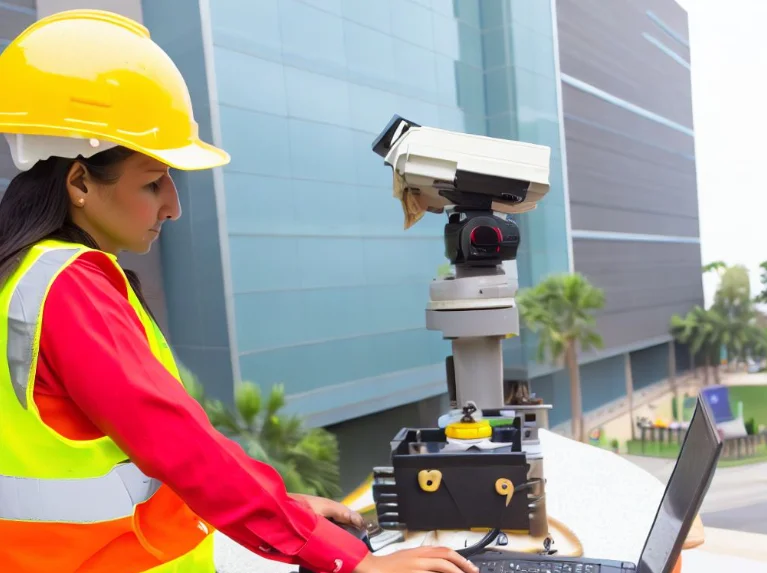As a hotel owner or manager, ensuring the safety and security of your guests is a top priority. A reliable video surveillance system is crucial for monitoring activity, deterring theft and misconduct, and providing video evidence if needed. When looking into surveillance options, two main systems stand out – NVR (network video recorder) and DVR (digital video recorder). But which one is better suited for a hotel environment? Here is an in-depth comparison of NVR vs DVR for hotels.
How They Work
Both DVR and NVR systems record footage from security cameras and allow it to be viewed and stored. The main difference lies in how they connect to the cameras.
A DVR connects to analog security cameras using coaxial cables. The cameras send a constant feed directly to the DVR, which encodes the footage and saves it to a hard drive for later retrieval. DVR systems create a closed circuit for recording and monitoring.

Analog vs IP Cameras
DVR systems require analog cameras. These are older camera technologies that send a continuous video signal through coaxial cables. Picture quality is standard definition. While inexpensive, analog cameras have limited features.
NVR systems work with modern IP network cameras. These digitally encode high definition video and transmit data through ethernet cables. IP cameras have a wider range of capabilities including motion detection, pan/tilt/zoom, night vision, smartphone access, and more. The high resolution footage provides more detail.
Installation and Wiring
A DVR system requires running long coaxial cables from each camera to the DVR unit. This entails a lot of cumbersome wiring through walls and ceilings. IP cameras only need ethernet cables run to network switches connected to the NVR. This greatly reduces the wiring required. IP cameras can also be completely wireless, removing the need to run any cables.

Video Storage Capacity
DVRs generally have lower video storage capacity. A standard DVR may have up to 4TB of storage, recording lower resolution footage from a limited number of cameras.
NVRs leverage much higher data storage capabilities. With up to 60TB of available storage and better compression of high definition video, NVR systems can record more cameras at higher resolutions for longer periods.
Expanding a DVR system usually involves adding more DVR units. NVR storage can be expanded simply by adding more hard drives.
Smart Features and Integration
IP cameras allow for more intelligent features powered by onboard processors and analytics. These include:
- Motion sensing to flag activity
- Face recognition to identify persons of interest
- License plate recognition for vehicle identification
- Heat maps showing high traffic areas
- People counting for occupancy monitoring
- This metadata can be searched or trigger alerts. It’s unavailable on analog DVR systems.
NVRs can also integrate with other hotel systems through the network, allowing surveillance footage to be viewed alongside access control systems, point-of-sale data, and more for a comprehensive view of operations. This level of integration is not possible with closed circuit DVR setups.
Remote Monitoring and Access
With a DVR system, live remote viewing and video playback is only available through a dedicated connection to the DVR box itself. This requires networking the DVR on site or using a VPN.
NVRs offer more flexible remote monitoring options. Authorized users can access live and recorded video from anywhere over the internet through secure login portals or mobile apps. No networking or VPN is required. This allows hotel managers and security personnel to check on things no matter where they are.
Reliability and Recovery
If a DVR fails or the recording hard drive crashes, the system goes down completely until the DVR can be repaired or replaced. This introduces potential gaps in coverage and vulnerability.
With NVR systems, camera recording is decentralized across the IP network. If the NVR or storage fails, the cameras keep recording. Once online again, the NVR automatically retrieves all footage directly from the cameras to prevent loss. This distributed architecture results in fewer gaps.
Scalability and Expandability
Adding more cameras means adding more DVRs, each with fixed storage and processing capabilities. Expanding requires increasingly complex cabling.
IP cameras can be added to the network incrementally without additional NVR hardware. Storage can be expanded as needed. Wireless options make deploying additional cameras simple. The flexible architecture scales smoothly.
Cost Considerations
DVR equipment and analog cameras are generally less expensive upfront. However, the extensive cabling required drives up labor costs for installation and expansion. Ongoing maintenance often involves replacing failing DVR units entirely.
While higher in initial equipment cost, NVR systems require less wiring and simplify installation. Storage and camera capacity can be gradually increased over time. Maintenance involves replacing faulty cameras if needed, not entire DVRs.
Conclusion
For hotel environments, NVR systems are usually the better choice. Their flexibility, scalability, extensive features, and intelligence make them ideal for properties both large and small. While cheaper upfront, a DVR system can be limiting and difficult to expand. Investing in a quality NVR system with good IP cameras pays off in the long run with more capabilities, simpler usage, and lower lifetime costs.

